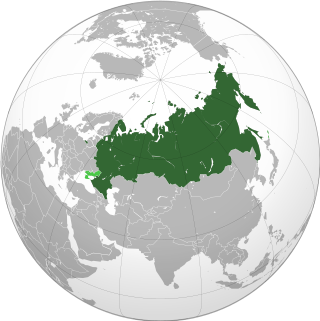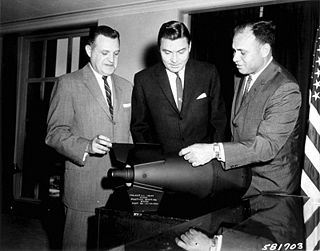Related Research Articles

The French Armed Forces are the military forces of France. They consist of four military branches – the Army, the Navy, the Air and Space Force and the National Gendarmerie. The National Guard serves as the French Armed Forces' military reserve force. As stipulated by France's constitution, the president of France serves as commander-in-chief of the French military. France has the eighth largest defence budget in the world and the second largest in the European Union (EU). It also has the largest military by size in the EU. A 2015 Credit Suisse report ranked the French Armed Forces as the world's sixth most powerful military.

Nuclear warfare, also known as atomic warfare, is a military conflict or prepared political strategy that deploys nuclear weaponry. Nuclear weapons are weapons of mass destruction; in contrast to conventional warfare, nuclear warfare can produce destruction in a much shorter time and can have a long-lasting radiological result. A major nuclear exchange would likely have long-term effects, primarily from the fallout released, and could also lead to secondary effects, such as "nuclear winter", nuclear famine, and societal collapse. A global thermonuclear war with Cold War-era stockpiles, or even with the current smaller stockpiles, may lead to various scenarios including the extinction of the human species.

In nuclear strategy, a first strike or preemptive strike is a preemptive surprise attack employing overwhelming force. First strike capability is a country's ability to defeat another nuclear power by destroying its arsenal to the point where the attacking country can survive the weakened retaliation while the opposing side is left unable to continue war. The preferred methodology is to attack the opponent's strategic nuclear weapon facilities, command and control sites, and storage depots first. The strategy is called counterforce.
Mutual assured destruction (MAD) is a doctrine of military strategy and national security policy which posits that a full-scale use of nuclear weapons by an attacker on a nuclear-armed defender with second-strike capabilities would result in the complete annihilation of both the attacker and the defender. It is based on the theory of rational deterrence, which holds that the threat of using strong weapons against the enemy prevents the enemy's use of those same weapons. The strategy is a form of Nash equilibrium in which, once armed, neither side has any incentive to initiate a conflict or to disarm.

Nuclear strategy involves the development of doctrines and strategies for the production and use of nuclear weapons.

In nuclear ethics and deterrence theory, no first use (NFU) refers to a type of pledge or policy wherein a nuclear power formally refrains from the use of nuclear weapons or other weapons of mass destruction (WMD) in warfare, except for as a second strike in retaliation to an attack by an enemy power using WMD. Such a pledge would allow for a unique state of affairs in which a given nuclear power can be engaged in a conflict of conventional weaponry while it formally forswears any of the strategic advantages of nuclear weapons, provided the enemy power does not possess or utilize any such weapons of their own. The concept is primarily invoked in reference to nuclear mutually assured destruction but has also been applied to chemical and biological warfare, as is the case of the official WMD policy of India.
Arms control is a term for international restrictions upon the development, production, stockpiling, proliferation and usage of small arms, conventional weapons, and weapons of mass destruction. Historically, arms control may apply to melee weapons before the invention of firearm. Arms control is typically exercised through the use of diplomacy which seeks to impose such limitations upon consenting participants through international treaties and agreements, although it may also comprise efforts by a nation or group of nations to enforce limitations upon a non-consenting country.

World War III, World War 3, WWIII, WW3, or the Third World War are the names given to a hypothetical global conflict subsequent to World War I and World War II. The term has been in use since as early as 1941. Some apply it loosely to limited or more minor conflicts such as the Cold War or the war on terror. In contrast, others assume that such a conflict would surpass prior world wars in both scope and destructive impact.
Military doctrine is the expression of how military forces contribute to campaigns, major operations, battles, and engagements. A military doctrine outlines what military means should be used, how forces should be structured, where forces should be deployed, and the modes of cooperation between types of forces. "Joint doctrine" refers to the doctrines shared and aligned by multinational forces or joint service operations.

The Intermediate-Range Nuclear Forces Treaty was an arms control treaty between the United States and the Soviet Union. US President Ronald Reagan and Soviet General Secretary Mikhail Gorbachev signed the treaty on 8 December 1987. The US Senate approved the treaty on 27 May 1988, and Reagan and Gorbachev ratified it on 1 June 1988.

The Russian Federation is known to possess or have possessed three types of weapons of mass destruction: nuclear weapons, biological weapons, and chemical weapons. It is one of the five nuclear-weapon states recognized under the Treaty on the Non-Proliferation of Nuclear Weapons.

The Single Integrated Operational Plan (SIOP) was the United States' general plan for nuclear war from 1961 to 2003. The SIOP gave the President of the United States a range of targeting options, and described launch procedures and target sets against which nuclear weapons would be launched. The plan integrated the capabilities of the nuclear triad of strategic bombers, land-based intercontinental ballistic missiles (ICBM), and sea-based submarine-launched ballistic missiles (SLBM). The SIOP was a highly classified document, and was one of the most secret and sensitive issues in U.S. national security policy.

Flexible response was a defense strategy implemented by John F. Kennedy in 1961 to address the Kennedy administration's skepticism of Dwight Eisenhower's New Look and its policy of massive retaliation. Flexible response calls for mutual deterrence at strategic, tactical, and conventional levels, giving the United States the capability to respond to aggression across the spectrum of war, not limited only to nuclear arms.
The Prevention of Nuclear War Agreement was created to reduce the danger of nuclear war between the United States and the Union of Soviet Socialist Republics. The agreement was signed at the Washington Summit, on June 22, 1973. The United States and the U.S.S.R. agreed to reduce the threat of a nuclear war and establish a policy to restrain hostility.

The militarisation of space involves the placement and development of weaponry and military technology in outer space. The early exploration of space in the mid-20th century had, in part, a military motivation, as the United States and the Soviet Union used it as an opportunity to demonstrate ballistic-missile technology and other technologies having the potential for military application. Outer space has since been used as an operating location for military spacecraft such as imaging and communications satellites, and some ballistic missiles pass through outer space during their flight. As of 2018, known deployments of weapons stationed in space include only the Almaz space-station armament and pistols such as the TP-82 Cosmonaut survival pistol.

The United States under secretary of defense for policy (USDP) is a high level civilian official in the United States Department of Defense. The under secretary of defense for policy is the principal staff assistant and adviser to both the secretary of defense and the deputy secretary of defense for all matters concerning the formation of national security and defense policy.

A tactical nuclear weapon (TNW) or non-strategic nuclear weapon (NSNW) is a nuclear weapon that is designed to be used on a battlefield in military situations, mostly with friendly forces in proximity and perhaps even on contested friendly territory. Generally smaller in explosive power, they are defined in contrast to strategic nuclear weapons, which are designed mostly to be targeted at the enemy interior far away from the war front against military bases, cities, towns, arms industries, and other hardened or larger-area targets to damage the enemy's ability to wage war. As of 2024, tactical nuclear weapons have never been used.

The "nuclear umbrella" is a guarantee by a nuclear weapons state to defend a non-nuclear allied state. The context is usually the security alliances of the United States with Australia, Japan, South Korea, the North Atlantic Treaty Organization and the Compact of Free Association. Those alliances were formed because of the Cold War and the Soviet Union. For some countries, it was an alternative to acquiring nuclear weapons themselves; other alternatives include regional nuclear-weapon-free zones or nuclear sharing.

Relations between the NATO military alliance and the Russian Federation were established in 1991 within the framework of the North Atlantic Cooperation Council. In 1994, Russia joined the Partnership for Peace program, and on 27 May 1997, the NATO–Russia Founding Act (NRFA) was signed at the 1997 Paris NATO Summit in France, enabling the creation of the NATO–Russia Permanent Joint Council (NRPJC). Through the early part of 2010s NATO and Russia signed several additional agreements on cooperation. The NRPJC was replaced in 2002 by the NATO–Russia Council (NRC), which was established in an effort to partner on security issues and joint projects together.
During the Russian invasion of Ukraine, several senior Russian politicians, including president Vladimir Putin, former president and prime minister Dmitry Medvedev, and foreign minister Sergey Lavrov, have made a number of statements widely seen as threatening the use of nuclear weapons. The possibility of Russia using tactical nuclear weapons, and the risk of broader nuclear escalation, has been widely discussed by commentators and in the media. Additionally, the Russian occupation of the Zaporizhzhia Nuclear Power Plant has led to a crisis over the safety of the plant and the risk of a nuclear disaster.
References
- ↑ Donnelly, Christopher N. (1988). Red banner: the Soviet military system in peace and war. Coulsdon, UK: Jane's Information Group. p. 106. ISBN 9780710604880.
- ↑ Rodionov, Igor (May 1992). "The fundamentals of Russia's Military Doctrine (Draft)". Voennaya Mysl. Moscow (published 1992-06-16). 1992 (Special edition): 2. ISSN 1938-257X. JPRS-UMT-92-008-L.
- 1 2 Dick, Charles J. (November 1993). The military doctrine of the Russian Federation. Occasional Brief. Vol. 25. Camberley, UK: Conflict Studies Research Centre. OCLC 45957118.
- ↑ "The Basic Provisions of the Military Doctrine of the Russian Federation". Rossiĭskie vesti. Translated by Foreign Broadcast Information Service. 1993-11-19 [published in Russian 1993-11-18]. p. 5. FBIS-SOV-93-222-S – via Center for Russia in Asia of the University of Hawaii at Manoa.[ dead link ]
- ↑ Dick, Charles J. (1994). "The military doctrine of the Russian federation". The Journal of Slavic Military Studies. 7 (3): 481–506. doi:10.1080/13518049408430155.
- ↑ Text of Military Doctrine of the Russian Federation, approved by a presidential decree dated 21 April 2000, via BBC Monitoring Service, Caversham Park, Reading.
- ↑ "Russia's Military Doctrine". ARMS CONTROL TODAY. April 2000.
- ↑ Main, S (April 2000). Russia's Military Doctrine. Occasional Brief. Vol. 77. Camberley, UK: Conflict Studies Research Centre. p. 1. OCLC 45957118.
- ↑ "Draft Military Doctrine of the Russian Federation". Krasnaya Zvezda . Translated by Foreign Broadcast Information Service. 1999-10-09. §1.1, pp.3–4.
- ↑ Arbatov, Alexei G. (July 2000). "The Transformation of Russian Military Doctrine: Lessons Learned from Kosovo and Chechnya". No. 2. George C. Marshall European Center for Security Studies. Marshall Center Papers.
- 1 2 "Voyennaya doktrina Rossiyskoy Federatsii" Военная доктрина Российской Федерации [Military doctrine of the Russian Federation]. scrf.gov.ru (in Russian). Moscow: Security Council of the Russian Federation. 2010-06-25 [presidential decree 2010-06-25]. Archived from the original on 2011-05-04. Note: the same URL is used for various revisions with different presidential decree dates.
- ↑ "The Military Doctrine of the Russian Federation" (PDF). Carnegie Endowment for International Peace.
- ↑ Blank, Stephen (25 February 2018). "Getting Russia's nuclear strategy mostly right". The Hill. USA. Retrieved 26 October 2018.
- ↑ Sinovets, Polina; Renz, Bettina (July 2015). "Russia's 2014 Military Doctrine and beyond: threat perceptions, capabilities and ambitions". Research Paper. Rome, IT: NATO Defense College, Research Division. 117. ISSN 2076-0957. Archived from the original on 2019-06-28. Retrieved 2016-02-06.
- ↑ "The military doctrine of the Russian Federation" (Press release). London: The Embassy of the Russian Federation to the United Kingdom of Great Britain and Northern Ireland. 2015-06-29 [presidential decree 2014-12-25]. Archived from the original on 2015-07-21. Retrieved 2016-02-05.
- 1 2 Pynnöniemi, Katri; Kari, Martti J. (December 2016). "Russia's New Information Security Doctrine" (PDF). Finnish Institute of International Affairs.
- 1 2 "Military Doctrine of the Russian Federation" (PDF). 26 December 2014. pp. 1–3. Retrieved 8 July 2023.
- 1 2 3 Pietkiewicz, Michał (2018). "The Military Doctrine of the Russian Federation" (PDF). Polish Political Science Yearbook. 47 (3): 505–520. doi:10.15804/ppsy2018305. S2CID 158768133.
- ↑ "Russia's National Security Space Strategy: How to Avoid Repeating History". 19 November 2020.
- ↑ West, Jessica (18 October 2020). "Outer Space". First Committee Monitor. 18 (2): 20.
- ↑ Bowman, Andrew S. (20 August 2020). "Russian Armed Forces: Military Doctrine and Strategy" (PDF). No. IF11625. Congressional Research Service.
- ↑ "Russian Military Doctrine".